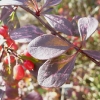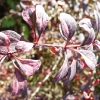Features
The purple/red, deciduous foliage turns bright red in autumn. The stem bears spines, which are formed from modified shoots, and the wood inside the stem is distinctively yellow in colour. Pale yellow, flushed with red, flowers are borne in spring followed by scarlet berries in autumn.
What to use it for
Good to bring autumn colour to informal borders or bedding. Useful for informal hedging and to secure boundaries thanks to the sharp spikes. Great for wildlife gardens as the spines protect nesting birds and the berries give them a food supply in the autumn. Also a good low maintenance garden choice.
How to look after it
This plant is low maintenance, just requiring minimal annual pruning.
How to prune it
Always wear thornproof gloves and clothing (with long sleeves) when pruning barberries, and consider wearing protective glasses if you need to get into the centre of the shrub. Pruning should be done in mid to late winter, although you should keep in mind that the plant flowers on old wood, so the more stems you remove the fewer flowers you will have the following year. Thin out the stems, removing about one in five stems each year, cutting them down to the base or a strong shoot near the base. Any dead wood can also be removed in midsummer (when it is easier to spot).
If the plant becomes large, straggly and only flowers at the ends of the stems, it can be cut back hard in late winter. Cut all the stems back to 30cm height, but be aware that this will lose you the following season’s flower display.
How to propagate it
Berberis plants can be propagated by cuttings, however they don’t always succeed, so you might find other methods more effective. Take semi-ripe cuttings from midsummer to autumn. Dip the cuttings in a hormone rooting compound to encourage rooting and keep the cuttings in a cold frame or cloche to protect them in cooler climates.
Seeds can also be collected from barberries when ripe and either sown outside immediately, or chilled in sand to break their dormancy before sowing in spring. They should germinate by the summer.
Common problems
Berberis plants are susceptible to powdery mildews, rusts and viral diseases. Berberis thunbergii can also suffer from defoliation due to sawfly attacks.
New plants can take at least 2 years before they flower, so don’t worry if you have a young plant which isn’t yet blooming. It may simply be that it isn’t mature enough to do so.
Other useful information?
Barberry fruits (particularly those of Berberis vulgaris), which are rich in vitamin C, can be used to make jam or jelly. However, all other parts of the plant (except the ripe berries) are harmful if eaten. Various berberis species are used around the world for their medicinal value. They contain an important anti-bacterial alkaloid called ‘berberine’ which is used in Asia to control tropical diarrhoea and certain eye diseases. It is obtained from the roots and rhizomes of various species. Around 7 tonnes of this is produced in India each year.
Barberries are alternative hosts for wheat rust (Puccinia graminis) which can devastate crops and, therefore, they are banned in much of North America.









